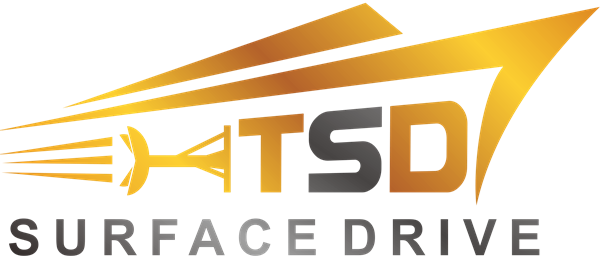Views: 0 Author: Site Editor Publish Time: 2024-06-14 Origin: Site









Cavitation, a crucial topic in fluid dynamics, significantly impacts propulsion systems, particularly surface drive systems. While these systems are designed to be less susceptible to cavitation, certain conditions, such as high-speed operation or improper design, can still induce cavitation. Understanding the mechanisms of cavitation and its manifestations in surface drive systems is essential for optimizing ship design and enhancing performance.
Cavitation occurs when the local pressure in a liquid falls below its vapor pressure, causing the liquid to vaporize and form bubbles. These bubbles collapse violently when they move to higher pressure regions, releasing high-energy shock waves. Cavitation is closely related to fluid velocity and pressure changes. According to Bernoulli's equation, in high-velocity regions, pressure drops, potentially leading to cavitation.
Cavitation can be categorized into vaporous cavitation and non-vaporous cavitation. Vaporous cavitation primarily occurs on the suction side of a propeller blade, while non-vaporous cavitation involves the release of dissolved gases in the fluid. The formation and collapse of cavitation bubbles increase fluid resistance and can cause erosion on the propeller surface, reducing propulsion efficiency.
Surface drive systems are unique propulsion systems where part of the propeller operates above the water surface, and the other part is submerged. Due to the partial exposure of the propeller, surface drive systems are theoretically less prone to cavitation compared to fully submerged propellers. However, cavitation can still occur under specific conditions, particularly during high-speed operation or if the system is improperly designed.
In surface drive systems, the propeller blades experience significant pressure and velocity changes near the water surface. These conditions create low-pressure zones conducive to cavitation. Additionally, the rapid alternation of propeller blades between air and water can induce cavitation by mixing air into the water.
Cavitation impacts surface drive systems in several ways:
Efficiency Reduction: Cavitation can erode the propeller blade surface, creating pits and increasing surface roughness, which elevates fluid resistance and reduces propulsion efficiency (Brennen, 1995).
Noise and Vibration: Cavitation generates high-frequency noise and vibration, affecting vessel comfort and potentially causing long-term structural damage. Studies indicate that cavitation is a primary source of noise and vibration in high-speed and military vessels (Blake, 1986).
Structural Damage: The high-pressure shock waves from collapsing cavitation bubbles can damage propeller blades and other propulsion system components, leading to material fatigue and micro-cracks, which can eventually cause blade failure (Franc & Michel, 2005).
To mitigate the negative impacts of cavitation on surface drive systems, engineers employ various control and optimization strategies:
Propeller Design Optimization: Optimizing the shape and material of propeller blades can reduce cavitation. Using high-strength materials and optimized blade geometry enhances cavitation resistance.
Surface Treatment: Special surface treatments, such as cavitation-resistant coatings, can minimize cavitation. These coatings reduce blade surface roughness and friction, lowering the likelihood of cavitation (Franc & Michel, 2005).
Operational Parameter Optimization: Adjusting vessel speed and propulsion system parameters can reduce cavitation. Operating within the designed rotational speed range avoids the formation of low-pressure zones, thereby reducing cavitation.
Numerical Simulation and Experimental Research: Numerical simulations and experimental studies provide insights into cavitation mechanisms and influencing factors, guiding design optimization. Modern computational fluid dynamics (CFD) tools simulate propeller flow characteristics under various conditions, predicting cavitation occurrence and development, thus aiding design improvement (Kuiper, 2010).
Example Analysis: A high-speed yacht equipped with a surface drive system experienced a significant reduction in propulsion efficiency. Upon investigation, frequent cavitation was identified during high-speed operation. By optimizing the propeller design and applying surface treatments, the yacht's propulsion efficiency was significantly improved, and cavitation was greatly reduced. This example demonstrates that scientific methods can effectively control and reduce the impact of cavitation on surface drive systems.
While surface drive systems are less prone to cavitation due to their design, specific conditions can still lead to cavitation, impacting system performance. By optimizing design, surface treatments, operational parameters, and employing numerical simulations and experimental research, the adverse effects of cavitation can be mitigated. Advances in fluid dynamics and materials science promise further improvements in the performance and reliability of surface drive systems, propelling the marine engineering industry forward.
Understanding and controlling cavitation not only enhances propulsion efficiency and comfort but also extends the lifespan of propulsion systems and reduces maintenance costs, holding significant importance for modern marine engineering and fluid dynamics research.
Blake, J.R. (1986). Cavitation and Bubble Dynamics. Cambridge University Press.
Brennen, C.E. (1995). Cavitation and Bubble Dynamics. Oxford University Press.
Franc, J.P., & Michel, J.M. (2005). Fundamentals of Cavitation. Springer.
Kuiper, G. (2010). Cavitation Research in Marine Propellers. Journal of Hydrodynamics, 22(5), 673-686.
